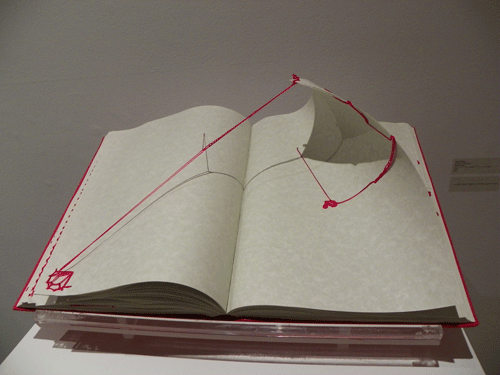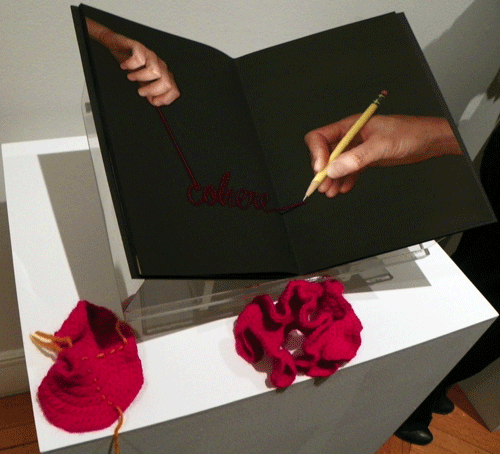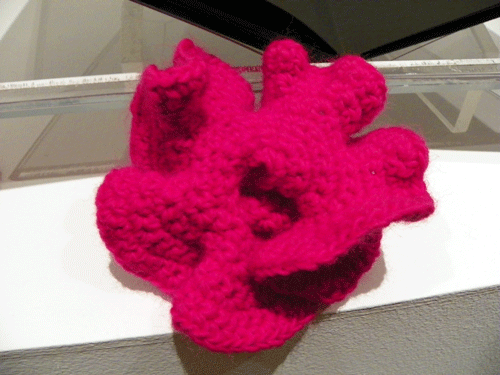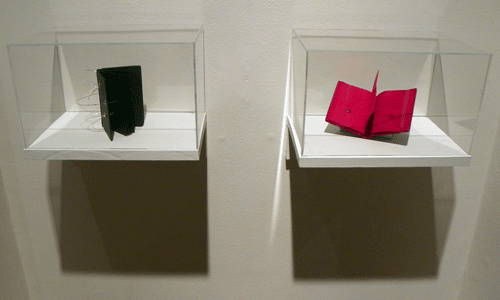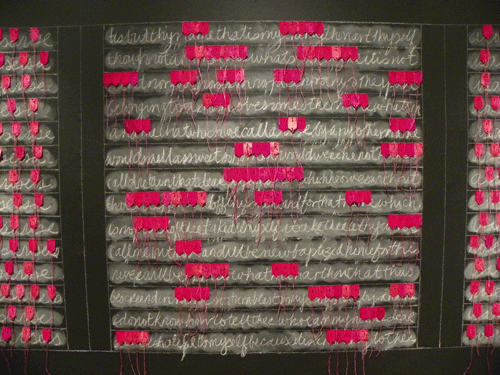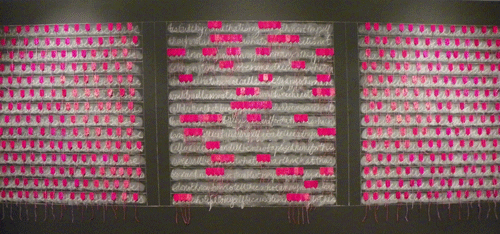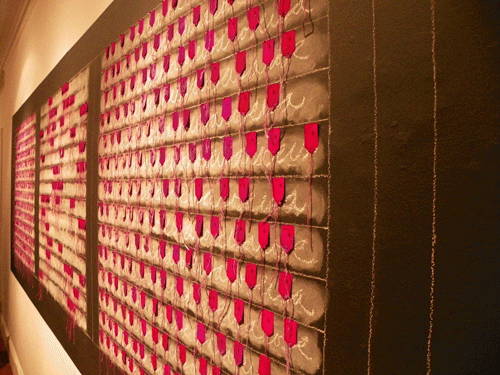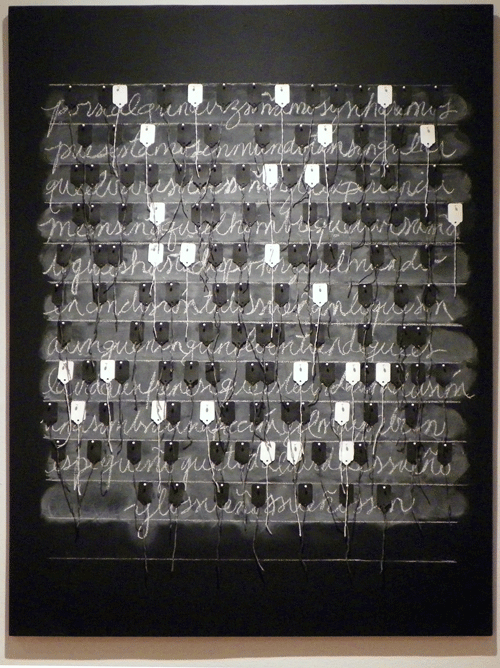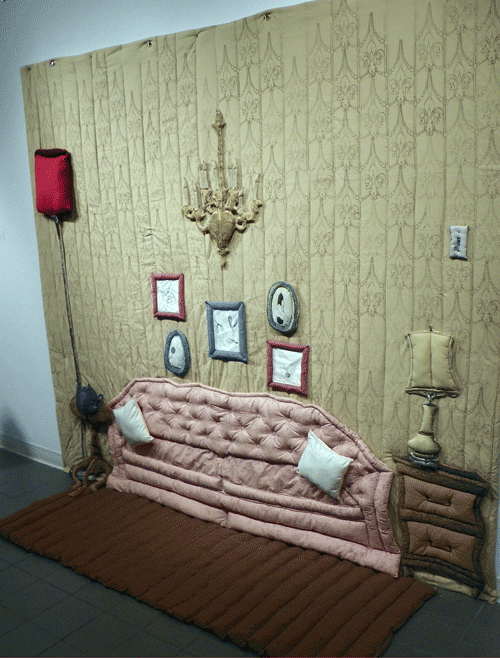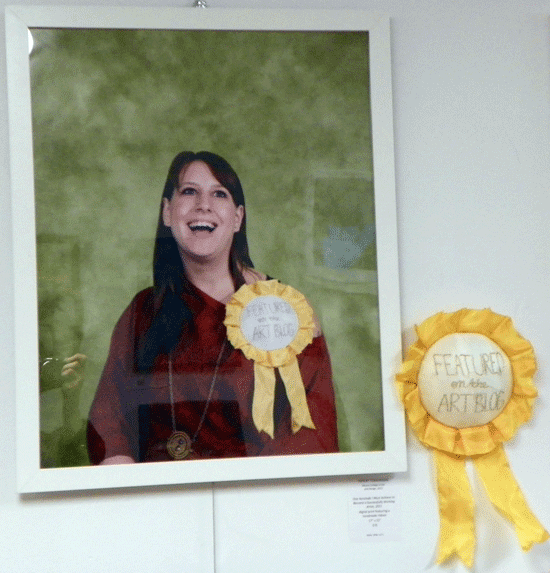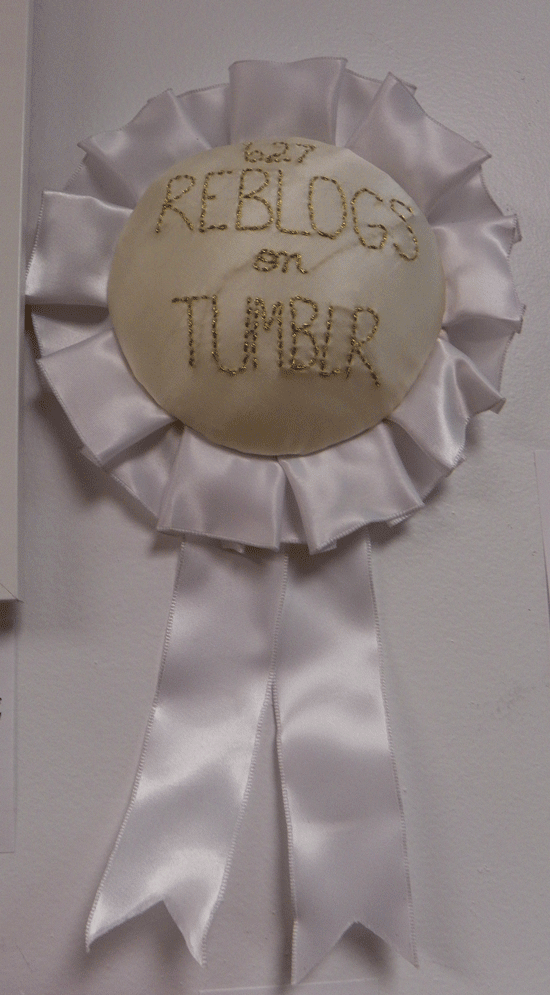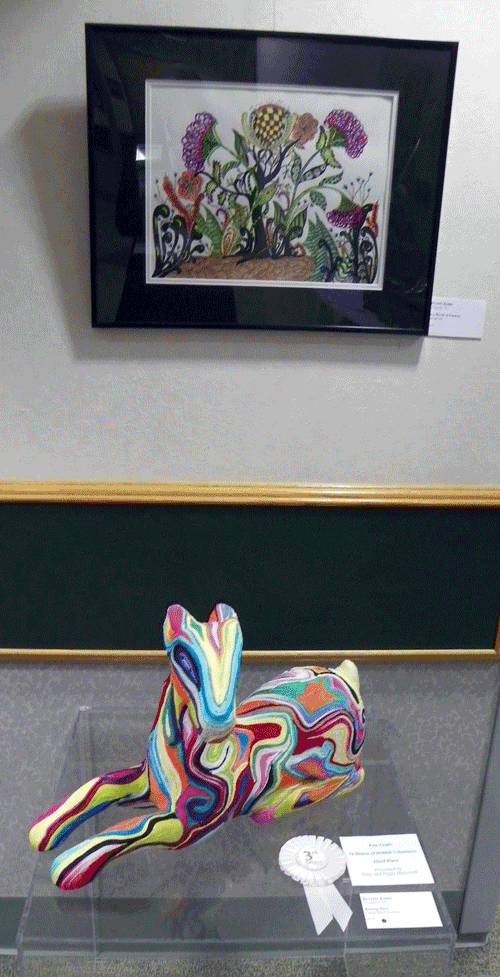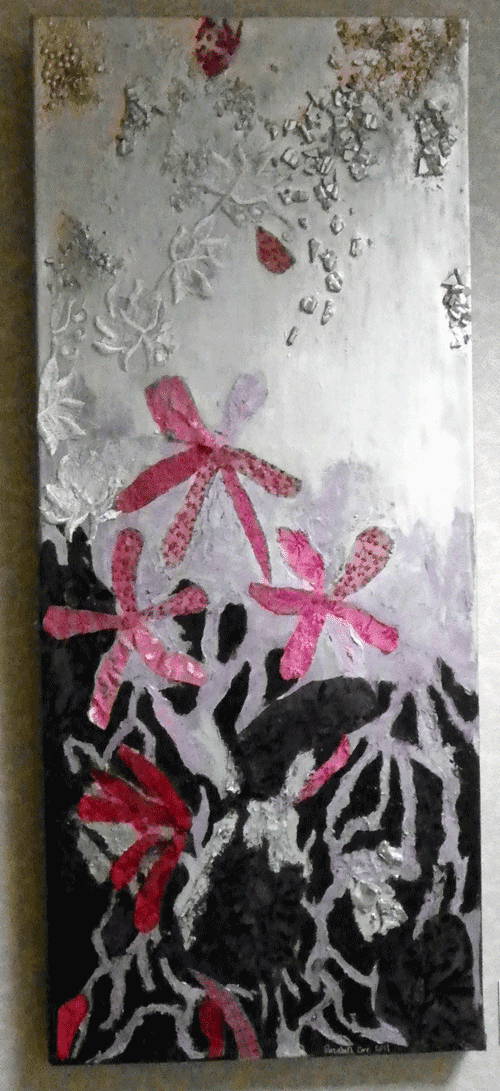Thread of Thought, Tara O’Brien at CFEVA
“I came to book arts as a librarian’s daughter and my poor father practically had a heart attack when he found out I was applying to grad school to do book arts. ‘Those are those nut jobs that take books and nail them to canvasses and call them art.'” said Tara O’Brien during her artist talk at The Center for Emerging Visual Artists. “A lot of what I was dealing with in Graduate School was making sure that that’s not what I’m doing, I’m not desecrating the Book. In fact, I spent a lot of time trying to figure out what is the future of the book, where is it going? In 2003 we were just getting into a huge tipping point with the Internet and you went there instead of to a book, unless you were my father. A lot of that time was spent thinking, ‘What is a book? What can it be? What’s the conceptual quality of the book?’ And so for the early pieces in the show, these two Thread of Thought and Plenum in the back is what could it be?”
Thread of Thought, Tara O’Brien at CFEVA
“Plenum, for example, is a term physicists use to describe all of the matter in the universe. So, what is a book, what can it be? It can be anything in the Universe. As I was talking earlier about Plenum the other thing I wanted you to do is approach the book when it was closed and when you open it it reveals a completely different structure inside, a surprise in finding a book. Which is what you get when you approach a novel and find that that stellar writing you kind of think, ‘Oh, they wrote that so beautifully.’ So, how can you combine the two in art and literature? How does a book work physically? How do you read a book page by page and how do you follow the threads of what the author is trying to get through to you? And then you can break it down to how are the symbols on the page giving you this linking. And that’s why I chose crocheting instead of knitting because each chain in a crochet is a link from one to the next one but you can build so much from a crochet chain. Both of these books are a single thread all the way through the entire book, the whole narrative, if you will, from the thread references as a you read a book. Like when you’ve gone fifty pages and and you don’t remember turning a single page because you’ve gotten so caught up in this single thread.”
Thread of Thought, Tara O’Brien at CFEVA, Hyperbolic Space
“Or you get to the point in a book here where you do realize your turning pages faster than you think.” Tara demonstrated how many of the pages pull the others with the thread and pages fly by like a magicians deck of cards. “And finally you almost turn in junior English denouement. So those books lead to thinking metaphysically, ‘What is the future of the book?’ I have no idea. Do I think books are going out of style? No. Not a chance, they just have a chance to evolve now. We’ve got eReaders, they’re here to stay, have fun with them but come back to these. The next group is the little tiny ones they all fall under the title Entelechy, Aristotle’s philosophy that every entity has a force that drives it to self-fulfillment and I just really like that idea. I’d like to know what this force is? What is it made up of? How does it break down? And in making these books I found that opening a page spread in a book is also kind of a metaphor for life.”
Thread of Thought, Tara O’Brien at CFEVA
“If you do these stitches you can see the full spread of a chapter or a moment to a link in your life. For example, as of now, all of February is one page spread for me, I don’t know what’s happening right now in this page spread but I can turn the page back in time and look at what happened in February in my life, and it’s clear now. Whereas in February I had no idea. A little crazy, right? I was really excited about this show because it offered me a chance to do new work. I do a lot of knitting, a lot of crocheting and I’m interested in a lot of things, I’m a library conservator so I get to look at a lot of old stuff, at ancient patterns and I get to look at old cookbooks and all these things that people have been doing forever. How are we going to interpret it?”
“My Winter project this year was to knit a pair of Latvian mittens, in Latvian culture for years and years and years the girls know they will marry at age sixteen and they make these incredibly complex mittens, one pair for every member of the family of her future husband. So, she’s been knitting five hundred pairs of mittens by the time she’s sixteen. They’re complex and double stranded and they start knitting when they’re five years old, it’s part of the culture.”
“Fast forward to 1995, and we have a mathematician from Latvia who finally solves the problem of making a model for hyperbolic space. So, what’s hyperbolic space? Well I’m going to do my best, but, it’s a mathematical thing – continuously negative space. It’s the ruffles on your lettuce, and what she was able to do was disprove Euclid’s theorum, given one straight line and a point off of the line there is only one other parallel line only. But this theorum doesn’t work on a globe but nobody could prove how it didn’t work and why not? In the 50’s they started experimenting with paper models but paper if you cut it, it falls apart.”
“So this person from a knitting culture sat down and said, ‘I know how to do this.’ And so she took these specifically exponentially increased, this one is six to one, you can see these two lines, when you take this continuously negative space and fold it you can bring two lines together and you get a set of parallel lines. As you go on with these, it takes forever to make a row, and then you take another fold and lay it next to that and now you have three parallel lines.
So, this is important for me because it references back to my idea of linking and connecting everything, here’s a woman who just knitted all the time because she was so practiced at it, all of a sudden these higher level ideas were coming out her just regular handwork and solving really massive problems. This book talks about the connection of this handwork from just the regular linking these little moments, these tiny little pearls of brilliant thoughts and made some coherence out of these higher thoughts. I hope that that makes sense.”
Thread of Thought at Center for Emerging Visual Artists through March 23rd.
Written and photographed by DoN Brewer, DoNArTNeWs Philadelphia Art News Blog Google and Wikipedia was used extensively to write this article.
Read more about FiberPhiladelphia2012 at Side Arts with Cassandra Hoo‘s excellent article.
[disclosure page] All ad links in this blog post go to Amazon.com

